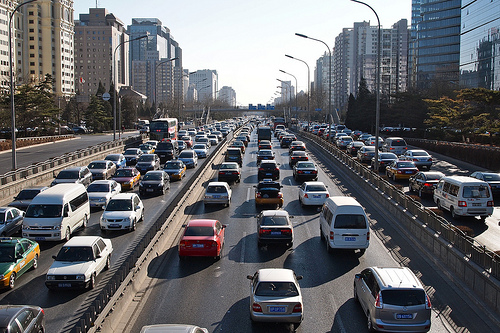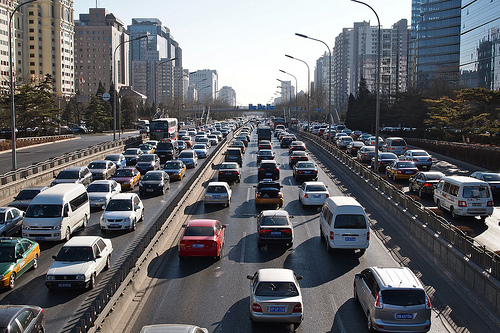 Transportation experts say there’s barely enough space on the roads in China’s largest cities for the 35 million cars that were bought during the past decade of frenzied consumerism. Photo: Remko TanisThis piece was written by Melinda Burns.
Transportation experts say there’s barely enough space on the roads in China’s largest cities for the 35 million cars that were bought during the past decade of frenzied consumerism. Photo: Remko TanisThis piece was written by Melinda Burns.
The new Great Wall of China is the “Great Wall” of cars stuck in city traffic, researchers say, and it will take more than restrictions on new license plates and car registrations to break the gridlock.
The problem is, there’s barely enough space on the roads in China’s largest cities for the 35 million cars that were bought during the past decade of frenzied consumerism, according to transportation experts at the University of California, Berkeley, and Massachusetts Institute of Technology.
In the ancient capital city of Xi’an, home of the buried armies of terracotta warriors, Lee Schipper said the joke is that if you want to drive in through the North Gate, you call your friend who’s leaving through the South Gate, so you can arrange to take his place. Schipper is a senior project scientist at UC Berkeley’s Global Metro Studies Center and a coauthor of a 2010 study on China’s crowded cities.
“The number of cars is going up much faster in China than the length of the roads in the cities,” Schipper said. “The greatest ‘communist’ society ever invented doesn’t know what to do. That’s what worries me. Cars are not something any kind of government can easily control if they’re cheap to buy and cheap to drive.”
In Shanghai, a city of more than 20 million where new car registrations are restricted to 6,000 monthly, commuter traffic has slowed to six to 10 miles per hour, well under the speed of a bicycle. The traffic’s a mess, even though only 20 percent of all daily trips in Shanghai are by car, compared to 80 percent in U.S. cities. For the majority of Shanghaians, who are walking or biking or waiting at the bus stops, it means breathing in a lot of bad air.
“It’s what I call hyper-motorization,” Schipper said. “China’s cities have expanded to make room for cars, but congestion levels have spiraled upward and average speeds downward. Things freeze up regularly.”
Building more roads and adding lanes, as China is doing, will not solve the problem, Schipper said. The amount of urbanized land in Beijing has tripled since 1990, but now commutes are longer. China could build more cities, but the new roads would fill up quickly, too.
Schipper and coauthors Wei-Shiuen Ng and Yang Chen, Ph.D. students at UC Berkeley and MIT, respectively, suggest that China has a window of opportunity to solve its traffic woes before car ownership jumps much higher. If China were to hike its fuel tax on gasoline, levy tolls at rush hour, raise parking fees, encourage compact development along bus lines, and give up more road space to cyclists and fast bus routes, it could get the traffic moving and avoid potentially much worse gridlock, the researchers found.
“Every motorist should know what it really costs to bring a car into a zone where land space is scarce,” Schipper said.
Most people in China still travel by bus, bike, or on foot. There are only 18 private vehicles for every 1,000 Chinese — roughly the level of ownership back in the 1920s in the United States. Today, there are 740 private vehicles for every 1,000 Americans. The average resident of China travels only 600 miles per year by bus, train, car, or plane, compared to 15,000 motorized miles per capita for Americans.
But China is now the top auto market in the world, having surpassed the U.S. in sales in 2009. Last year, General Motors Co. sold more cars in China than in the U.S. If current trends continue, the research shows, China can expect 146 million private cars by 2020, or four times the number it has now.
“My role is not telling China what to do,” said Schipper, who has traveled to the country 20 times in the past decade to talk to city and transportation planners. “I can point to the consequences of what they do. The present path in China is towards more and more cars. Smaller towns of under 2 million people are not as crowded, but then people flee to the smaller towns and they get gummed up, too.”
This month, Beijing officials launched a lottery for new license plates to restrict new cars in the city to 240,000 in 2011. Last year, more than 700,000 cars were sold in the city. But the measure may backfire, Schipper said. Beijing residents rushed to buy 20,000 cars the day before the lottery went into effect; and people will likely drive their cars more now, sharing them with family and friends. Events such as the 10-day, 60-mile traffic jam on the outskirts of Beijing last summer could become more common.
A number of Chinese cities, including Beijing, are building rapid transit systems in which buses can travel in segregated lanes with priority at intersections. But these efforts to boost mass transportation are being overwhelmed.
“The Chinese don’t have much time,” Schipper said. “The longer they wait or take missteps, the harder it will be to recover. More and more consumers will be used to owning and using cars, and city development will be distorted increasingly towards a car-oriented pattern. The experience from nearby cities in Asia — Bangkok, Jakarta, and Manila, to give three notorious examples — suggest that recovering from this pattern will be very, very difficult.”
Related:
This article was syndicated with permission from Miller-McCune, an online and print magazine that focuses on practical options for solving serious problems, particularly if the options are backed by quality research and evidence.


